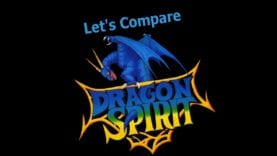Let’s Compare ( Donkey Kong ) THE MEGA VIDEO
Gaming History Source
If you like these videos, Please Consider becoming a patreon or making a Thanks Donation.
https://www.patreon.com/ghs?ty=h
The NES Version featured in this video is a hack including the pie / cement factory. I added it to demonstrate what it would have looked like on the original hardware.
Announcement ! I am going to duplicate this channel on Rumble. Link is in the closing credits.
Video Locations
1. Arcade 1:15
2. MS Dos ( Original ) 3:58
3. Apple 2 6:38
4. Atari 2600 ( Original ) 9:37
5. BBC Micro ( Killer Gorilla ) 11:14
6. ZX Spectrum 14:28
7. MSX 18:27
8. Commodore Vic 20 22:31
9. Dragon 32 ( Donkey King ) 26:01
10. TRS-80 CoCo ( Donkey King ) 29:59
11. Coleco ( Mini Arcade ) 33:50
12. Game & Watch 35:18
13. Intellivision ( Original ) 37:31
14. Intellivision ( Remake ) 39:50
15. Atari 2600 ( Version 2 ) 43:43
16. Atari 2600 ( Donkey Kong VCS ) 47:11
17. Colecovision ( Original ) 50:40
18. Colecovision ( Super Donkey Kong ) Prototype 53:39
19. Coleco Adam 56:44
20. Gameboy Color ( Game & watch Gallery 2 ) 59:39
21. TI99 1:03:07
22. Atari 8-bit 1:06:48
23. Atari 5200 ( Home Brew Port ) 1:09:07
24. DOS ( Champ Kong ) 1:11:38
25. Amstrad 1:15:24
26. Commodore 64 ( Ocean ) 1:19:12
27. Commodore 64 ( Atari ) 1:22:34
28. Atari ST ( Kid Kong ) 1:26:12
29. Amiga 1:29:53
30. Atari 7800 1:32:50
31. Atari 7800 ( Arcade remake ) 1:35:54
32. Gameboy Advance 1:39:37
33. Gameboy Color 1:42:54
34. Super Gameboy 1:46:29
35. Famicom Disk System 1:50:13
36. NES ( Pie Factory Hack ) 1:53:27
37. MS Dos ( Donkey Kong PC ) 1:56:54
38. Super Nintendo ( Classic Kong ) 2:00:37
39. Windows ( Donkey Kong Craze )2:04:26
40. Flash ( New Grounds )2:07:59
41. TRS-80 ( Arcade ) 2:11:39
42. Unity ( Jump man returns ) 2:15:34
43. Windows ( Remake ) 2:17:06
Video Description by:
https://strategywiki.org/wiki/Donkey_Kong
Donkey Kong first arrived in the arcades in 1981 as the game that Shigeru Miyamoto designed to replace the ill-fated arcade game Radar Scope. It featured a mustachioed man in brightly colored overalls who would go on to achieve monumental fame and bring Nintendo a lot of fortune. Originally he was simply called Jumpman and was labeled a carpenter, he was eventually named Mario and identified as a plumber.
When Donkey Kong became popular, Atari sought to buy the home rights to the game. But at that time, Coleco bid for the rights as well when trying to snag a killer launch title for their soon to be released ColecoVision. Coleco got the home cartridge rights while Atari ended up with the computer diskette rights. This arrangement worked out well until it backfired at the 1983 CES show, where Coleco presented their enhanced version of Donkey Kong for the Coleco ADAM computer. Atari, upset over the apparent breach of contract, ordered Nintendo to make Coleco shut down the display.
When the Famicom launched in 1983, Nintendo provided their three biggest arcade hits as launch titles. Donkey Kong was an obvious choice. The Famicom conversion is a very close port of the original game with only minimally altered graphics, but sadly featuring the omission of the conveyor belt stage. Despite the missing stage, the remaining three stages make it in tact, and provide all of the same challenges found the arcade version.














